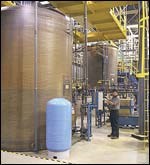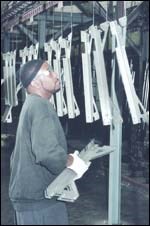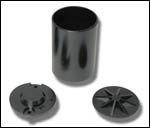Is In-house E-Coating Right For Your Company?
Here’s a decision-making framework.
Should your company electrocoat its products in-house or should it outsource the work? This question is one that has been brought up in the front office of many companies ever since e-coat became recognized as an effective and desirable coating process.
Over the years, we’ve seen numerous case studies in various industrial coating trade magazines about how certain companies have benefited by installing their own e-coat system. In each case, the company was very pleased with its decision to install an e-coat system. However, we do not see stories about companies who have installed an e-coat system and later found that it was a bad decision. No one wants a negative case study about his or her company published in a trade journal, and rightly so.
Featured Content
Sometimes things change after the decision to install an e-coat system, and there’s not much anyone could have done to prevent a negative turn of events. However, the more aware you are of the elements of consideration for both the in-house option and outsource option, the more likely you will make the right decision. If your company is thinking about installing an in-house e-coat system, perhaps the following discussion will be helpful.
In-House Advantages and Limitations
An in-house e-coat system can offer some very exciting benefits, such as:
- Eliminating requirements to pack up and ship parts for coating.
- Providing an opportunity to develop handling efficiencies within the plant.
- Virtually eliminating the pipeline for the coating process, reducing work-in-process inventory.
- Ensuring that the coating equipment and process is compatible with products and substrates to be coated.
- Providing control over scheduling of the coating process.
- Enabling complete in-house quality control.
There are also several potential disadvantages associated with operating an in-house e-coating process. Don’t overlook these.
- There will be a considerable investment in both capital equipment and human resources.
- Plant space must be allocated to the coating process. This might require re-arrangement of facilities to accommodate such items as utilities and to ensure efficient material movement.
- The e-coating function will require different skills and training than other manufacturing operations, and employee
turnover in this area can be a concern. - The coating equipment will require a different kind of maintenance than other manufacturing equipment, necessitating training for maintenance personnel.
- Coating quality depends on how well processes within the coating system are maintained. The people running your e-coat operation must do a good job of process control.
- Your processing options become virtually fixed. Once you install your own e-coat system with a chosen pre-treatment process and coating material, basically, that is what you’ll have to use for all of the products you e-coat. Of course, you can still outsource certain products with differing requirements.
-
You will be introducing a “metal finishing” process into your plant operations. Your facility will be subject to environmental compliance issues that you may have not had to deal with before.
The Outsourcing Option
Like in-house e-coating, outsourcing has potential strong points and weaknesses. On the plus side, you’ll have no investment requirement for capital equipment and no additional human resources to hire, train and
support.
Plant space that would be required for the e-coat operation is available for other manufacturing or storage requirements, and your supplier will maintain the coating equipment. Your maintenance team will not be required to support an additional e-coat system. Similarly, process control is (or should be) your coating supplier’s expertise, so you can expect and demand good control.
Outsourcing may give you more process flexibility. If you need a pretreatment process or a coating material that is not available at the chosen supplier, you might find another supplier that does have that service. You can split work among suppliers, and partner with suppliers to develop new applications. Your plant will not face additional environmental compliance issues. Your supplier will be responsible for them.
Many of the advantages of the in-house e-coat system could also be considered as disadvantages of the outsource option. For example, if your parts are very large or bulky, outsourcing becomes tricky. Generally, e-coat systems at custom coaters are designed to handle small to medium-size parts. Most systems designed to coat very large components are captive in-house operations that are not set up to do custom coating work for you.
Regardless of part size or configuration, you’ll have to deal with packaging, handling, shipping and receiving issues. Depending on the distance to an appropriate coater, freight can become a major cost factor, and you may have to add pipeline inventory to maintain operations.
A system to monitor coating quality will need to be established to ensure that you’re receiving coated parts that meet your specifications. You’ll need to find a supplier with equipment that is compatible with your product requirement, or, if this is not possible, settle for a compromise. For example, the supplier might not have the optimum pretreatment for the substrate used with your product. Or, the e-coat material used by the supplier might not provide the optimum gloss level for your product.
Rules of Thumb
We’ve looked at the pros and cons of e-coating in-house and outsourcing the work. Let’s assume your planning team has looked at both options and has decided to further investigate an in-house e-coat system. The team will probably be asking this question: “Is there some general rule of thumb that might be used to determine if an in-house e-coat project should be seriously pursued?”
Well, here are two such rules that have been used to make strategic decisions regarding the serious consideration of an in-house e-coat system.
Rule 1. Think about an in-house e-coat system when the annual cost for the outsource e-coat service is equal to or greater than the capital investment requirement. Or, when the annual cost for the outsource e-coat service is approaching the capital investment requirement and the annual freight cost (including handling) is approaching 20% of the capital investment requirement.
Rule 2. Seriously consider an in-house e-coat system when Rule Number 1 is met and there is a projected 80% (or higher) probability the production volume level will hold up (or increase) for at least five years.
Let’s talk about how to pull the information together to use these rules. If your company is already outsourcing e-coat work, it will be very easy to get the annual cost information for that service. It should be available from internal accounting records.
However, arriving at the capital investment required for an in-house system will involve more effort. All that’s really needed is a reasonable estimate, but many equipment suppliers don’t like to provide “ball park” estimates because they fear these numbers will be treated as actual quotes. You might have to work with an equipment supplier and at least develop a preliminary set of general specifications before you can get any meaningful numbers. This is not a bad thing—you’ll have to do that anyway if you decide to proceed with your study. Plus, it will be an educational exercise.
Now, look at freight costs. If you’re currently outsourcing, there should be a way to separate the costs specifically related to outsource coating services. If not, your freight hauling company should be able to furnish at least a reasonable estimate.
If you are looking at a new plant and/or a new product, the numbers will have to be generated from the operational planning projections and product specifications.
Rule 2 relates to project longevity. It emphasizes the importance of knowing the market. With Tier One suppliers, for example, Rule 2 emphasizes the importance of a “partnering” relationship with the customer or OEM, if that is possible.
Applying the Rules
Remember, these rules of thumb are only intended to provide a relatively quick guide for strategically evaluating the question of whether or not your company should seriously consider installation of an in-house e-coat system. Here’s a look at a couple of examples of how you might apply this approach.
Let’s say your e-coat service supplier is just down the street. Your parts are relatively small. Annual cost to outsource e-coat is running about $500,000. The estimated capital investment for an e-coat system is about $2 million. You can’t determine how long the volume level will continue. This data is telling you to stick with the outsource
option!
However, let’s say the only e-coat service supplier that can handle your product is 300 miles away. Your parts are difficult to package and ship. The annual cost to outsource e-coat is about $1.8 million. Your annual shipping cost is about $500,000. The estimated capital investment for an e-coat system is about $2 million. There is firm assurance that your product will be needed at the current volume level or above for at least five years. You should take a serious look at an in-house e-coat installation!
Other Considerations
Of course, the size, configuration and arrangement of an in-house e-coating line can be customized to meet your product and volume requirements. The cost of e-coat systems and their support equipment can vary considerably. If you can clearly define what your company wants the e-coat system to do, an equipment supplier just might be able to provide a system at a cost level that can be justified with the volume of production available to support it.
Remember that to justify an in-house system you basically need enough of two things: production volume and time. Production volume needs to be there to support an efficient operation, and the project needs to be long enough to amortize the capital investment.
If an in-house e-coat system appears to be justified but your company management is opposed to diverting the available capital or adding the human resources necessary, here’s another option for you. You might want to consider finding a custom coating company that will partner with your company to provide a coating service in your facility. This can provide many of the advantages of both in-house operation and the outsource option.
RELATED CONTENT
-
Wireless Carrier Fleet Provides Modular Overhead Conveyance
Wireless, modular conveyor system provides flexibility and scalability for carrying parts through finishing processes.
-
Salt Spray Vs. Cyclic Corrosion Tests
Joseph Subda, ecoat specialist for Axalta Coating Systems, explains the difference between these two corrosion resistance tests.
-
A Protective Decorative Electrolytic Coloring Process for Aluminum
The main task of this work was to study the influence of the different parameters on the electrolytic coloring process for aluminum.






















